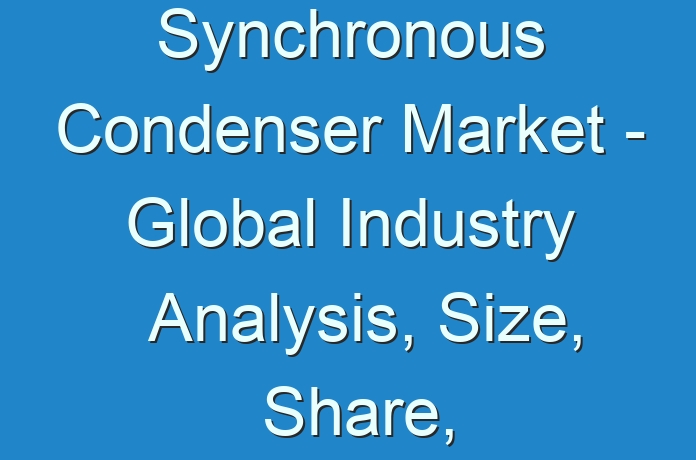
Synchronous condensers are synchronous motors that are usually employed for power factor correction in power lines. Electrical circuits involving induction motors or inductive loads are usually encountered with lagging power factors, due to which the efficiency of the system goes down. Lagging power factors result in the loss of energy. Synchronous condensers are introduced in such circuits to cancel out the lagging power factor. They feed the circuits with leading power factors. However, synchronous motors can be used to compensate leading and lagging power factors by supplying reactive power to the line. This helps in enhancing the voltage regulation of the line. Synchronous condensers also help in improving the efficiency of long power transmission lines. Furthermore, synchronous condensers help in avoiding short circuit conditions and transient fault conditions in power grids, due to their ability to absorb and produce reactive power. Other benefits of synchronous condensers include provision of sufficient short-circuit power and inertia, steady-state and dynamic voltage control, reactive power control of dynamic loads, which can be incorporated for stabilization of grids, line-commutated converters based high voltage DC transmission links, renewable power generation based transmission grids, and retirement/shut-down of thermal power plants. However, use of synchronous condenser has few disadvantages such as losses in the motor, high maintenance cost due to rotating component, noise, high cost at low power ratings compared to static capacitors method, and need of excitation equipment for starting the synchronous motors. This gives rise to the need for employment of substitute methods for power correction such as static capacitor method or phase advancer method.
Based on the cooling method, the synchronous condenser market can be segmented into air cooled, water cooled, and hydrogen cooled. The hydrogen cooled segment dominates the market. This trend is anticipated to continue during the forecast period. This is primarily due to the better results of hydrogen cooled synchronous condensers in terms of cooling and losses, as the density of hydrogen is much lesser while thermal conductivity is much higher than that of air.
Request a Sample-
https://www.transparencymarketresearch.com/sample/sample.php?flag=S&rep_id=30050
Based on reactive power rating, the synchronous condenser market can be segmented into up to 100 MVAr, 100-200MVAr, and above 200MVAr. The need for power factor correction is increasing due to the rising demand for reactive power for grid stabilization and voltage regulation. Moreover, the costs with synchronous condensers employed for low power ratings is high. Therefore, synchronous condensers with the rating above 200MVAr are highly preferred. The above 200 MVAr segment is likely to expand during the forecast period.
In terms of geography, the market can be segmented into Asia Pacific, North America, Latin America, Europe, and Middle East & Africa. North America dominates the synchronous condenser market. The market in the region is anticipated to expand in the near future due to factors such as installation of new power plants in the U.S. and increasing use of synchronous condensers in the existing power plants in the country. Asia Pacific is also one of the major markets for synchronous condensers and is anticipated to expand at a descent pace, especially in the countries such as China.
Major players operating in the global market include Siemens AG, General Electric, Eaton Corporation Plc, ABB Ltd., Voith GmbH, Hyundai Ideal Electric Co., and WEG Electric Corp.
Request for covid19 impact analysis –
https://www.transparencymarketresearch.com/sample/sample.php?flag=covid19&rep_id=30050
Companies are expanding their market share by adopting several marketing and merger & acquisition strategies. Companies are also shifting their manufacturing facilities to developing countries, such as China and India in Asia Pacific, to avail the easily available land, cheap labor, and government subsidies in the region.
This study by TMR is all-encompassing framework of the dynamics of the market. It mainly comprises critical assessment of consumers’ or customers’ journeys, current and emerging avenues, and strategic framework to enable CXOs take effective decisions.
Our key underpinning is the 4-Quadrant Framework EIRS that offers detailed visualization of four elements:
- Customer Experience Maps
- Insights and Tools based on data-driven research
- Actionable Results to meet all the business priorities
- Strategic Frameworks to boost the growth journey
Pre-Book now-
https://www.transparencymarketresearch.com/checkout.php?rep_id=30050<ype=S
The study strives to evaluate the current and future growth prospects, untapped avenues, factors shaping their revenue potential, and demand and consumption patterns in the global market by breaking it into region-wise assessment.
The following regional segments are covered comprehensively:
- North America
- Asia Pacific
- Europe
- Latin America
- The Middle East and Africa
The Synchronous condenser market has been undergoing some remarkable growth dynamics, shaped increasingly by digital technologies and environmental sustainability concerns of product development. Over the decades, the feedstock variability and the onslaught of cheaper substitutes have squeezed in profit margins of the chemical and materials sector. On the other hand, the value chain of several businesses in the Synchronous condenser market has undergone overhaul, increasingly rendering some aspiring players with greater control over the forces and demand. The penetration of Industry 4.0 in in the market has stirred game-changing trends for range of stakeholders in the overall chemicals and materials sector. Manufacturing and production environments of businesses in the Synchronous condenser market are keen on formulating and implementing strategic frameworks that will turn them into digital enterprises.
More Trending Report-





